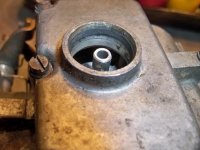poolboy
Yoda
Offline
A couple of things to consider in CJD's post.
Because the float level is normally set with the carb upside down with the float tab resting on the needle valve, lowering the float, say from 17 mm to 15 mm actually increases the level of fuel in the float chamber...17mm, btw is my recommendation.
Also, If it's percolation, and not an extremely low float level (high fuel level) or otherwise too rich a mixture, the percolation starts at the very bottom of the float chamber causing the fuel to percolate up the jet which is open about as low in the float chamber as possible and still pick up fuel.
Think of the old Maxwell House coffee commercial..blip, blip....blip blip blip blip.
Here's a picture of the jet, illustrating the depth of the jet in the float chamber. It's actually down in the depths of the float chamber plug's cavity.

The cure for percolation is protecting the fuel in the float chamber from the heat of the exhaust system.
Because the float level is normally set with the carb upside down with the float tab resting on the needle valve, lowering the float, say from 17 mm to 15 mm actually increases the level of fuel in the float chamber...17mm, btw is my recommendation.
Also, If it's percolation, and not an extremely low float level (high fuel level) or otherwise too rich a mixture, the percolation starts at the very bottom of the float chamber causing the fuel to percolate up the jet which is open about as low in the float chamber as possible and still pick up fuel.
Think of the old Maxwell House coffee commercial..blip, blip....blip blip blip blip.
Here's a picture of the jet, illustrating the depth of the jet in the float chamber. It's actually down in the depths of the float chamber plug's cavity.

The cure for percolation is protecting the fuel in the float chamber from the heat of the exhaust system.
Last edited:

 Hi Guest!
Hi Guest!

 smilie in place of the real @
smilie in place of the real @
 Pretty Please - add it to our Events forum(s) and add to the calendar! >>
Pretty Please - add it to our Events forum(s) and add to the calendar! >> 
